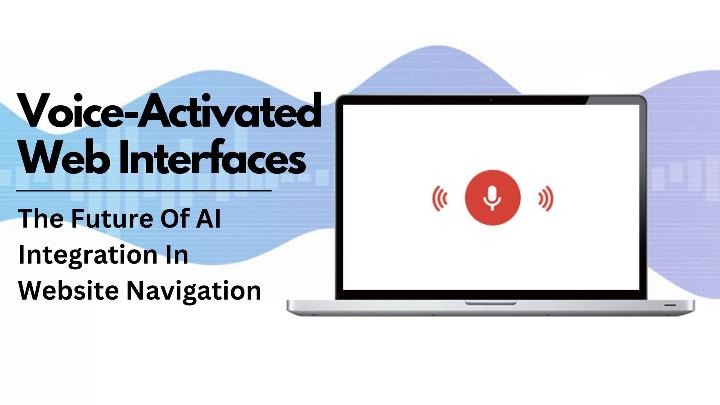
In the ever-evolving landscape of technology, Artificial Intelligence (AI) continues to reshape the way we interact with digital platforms. One of the most intriguing developments in AI integration is the emergence of voice-activated web interfaces. As we explore the potential and impact of voice-activated interfaces, we’ll delve into how they are revolutionizing website navigation and design. Welcome to the future of AI integration in website navigation.
The Rise of Voice-Activated Web Interfaces
Voice-activated web interfaces, often referred to as voice user interfaces (VUIs), have gained remarkable prominence in recent years. Enabled by advancements in natural language processing and machine learning, voice-activated interfaces have transcended the realm of novelty to become a practical and efficient means of interacting with technology.
Companies like Amazon, Google, and Apple have paved the way with their voice assistants — Alexa, Google Assistant, and Siri, respectively. These technologies have become household names, and their widespread adoption has catalyzed the integration of voice-activated interfaces in various domains, including website navigation.
The Role of AI in Voice-Activated Interfaces

At the heart of voice-activated web interfaces lies AI, particularly natural language processing (NLP) and speech recognition technology.
SFWPExperts is at the forefront of innovative web design and development, and now, we’re venturing into the future with Voice-Activated Web Interfaces. Explore the boundless possibilities of this cutting-edge technology as we redefine user interactions and navigation on your website. Welcome to the future of seamless, voice-powered web experiences.
Here’s how AI plays a pivotal role in making these interfaces function seamlessly:
1. Speech Recognition
AI algorithms enable voice-activated interfaces to recognize and interpret spoken words with remarkable accuracy. These algorithms continuously improve through machine learning, allowing VUIs to adapt to diverse accents, languages, and speech patterns.
2. Natural Language Understanding
Beyond recognizing words, AI-powered VUIs understand the context and intent behind user queries. They can discern complex requests, follow conversational threads, and provide relevant responses. This natural language understanding (NLU) is what makes voice interactions feel more intuitive and human-like.
3. Personalization
AI-driven voice-activated interfaces can learn from user interactions and preferences, providing personalized experiences. They can remember previous requests, tailor responses, and make recommendations based on user history.
4. Continuous Improvement
With AI, voice interfaces can continually learn and adapt. They use feedback and data analysis to refine their responses, making them more accurate and contextually relevant over time.
Read More: Voice-Activated Web Interfaces: The Future Of AI Integration In Website Navigation
Read More Articles:
- Signs Of Good Web Design: How to Identify a Well-Crafted Website
- How To Redesign A WordPress Website Without Losing SEO?
- Streamlining Web Development: The Efficiency Gains Of AI In Coding
Reference Profile Websites:
- https://moz.com/community/q/user/sfwpexperts?_=1696589032068
- https://foursquare.com/garyv9781498
- https://www.vorpx.com/forums/users/garyvault/
- https://gitlab.nic.cz/garyvault
- https://adbellmedia.com/profile/gary-vault
- https://adbellmedia.com/posts/what-is-generative-ai-how-it-works-with-website-design
- https://tonow.mn.co/members/19325576
- https://tonow.mn.co/posts/43417821
- https://shapshare.com/garyvault
- https://shapshare.com/post/520071_https-www-sfwpexperts-com.html
- https://shapshare.com/post/520077_https-www-sfwpexperts-com-website-design-los-angeles-california.html
- https://v4.phpfox.com/garyvault
- https://v4.phpfox.com/garyvault/?link-id=344
- https://v4.phpfox.com/garyvault/?link-id=345
- https://memberstayshop.mn.co/members/19326316
- https://usupdates.com/author/garyvault/
- https://mastodon.social/@sfwpexperts
- https://mastodon.social/@sfwpexperts/111188197393293301
- https://mastodon.social/@sfwpexperts/111188206279913795
- https://wakelet.com/@GaryVault74048
- https://wakelet.com/wake/dMdolkST-KhQw5eMMQ42G
- https://gab.com/garyvault
- Wordpress Website Design Company
- https://gab.com/garyvault/posts/111188272667172100
- https://sco.lt/9Afslk
- https://sco.lt/5RbJui
- https://ai.ceo/garyvault
- https://ai.ceo/post/154771_https-www-sfwpexperts-com.html
- smm
- https://ai.ceo/read-blog/91043
- https://baitk.com/garyvault
- https://baitk.com/post/114229_https-www-sfwpexperts-com.html
- https://baitk.com/post/114230_https-www-sfwpexperts-com-website-design-los-angeles-california-web-design-losan.html
- https://baitk.com/read-blog/70018
- https://www.hashtap.com/@gary.vault
- https://www.hashtap.com/@gary.vault/best-practices-for-wordpress-website-design-in-2023-PnwNmXPKmJg7
- https://gitea.com/garyvault
- https://gitea.com/WordpressWebsiteDesign
- https://gitea.com/WebsiteDesignLosAngeles
- https://www.quora.com/profile/Gary-Vault
- https://webdesignservicela.quora.com/What-s-New-in-AI-and-ML-10-Technologies-that-Are-Evolving-Right-Now
- https://uconnect.ae/garyvault
- https://uconnect.ae/post/122537_https-www-sfwpexperts-com-wordpress-website-design-company-website-design-compan.html
- https://uconnect.ae/post/122541_https-www-sfwpexperts-com-website-design-los-angeles-california-losangeles-webde.html
- business emails
- https://uconnect.ae/read-blog/1044
- https://akb.tribe.so/user/garyvault
- https://akb.tribe.so/post/what-s-new-in-ai-and-ml-10-technologies-that-are-evolving-right-now-artific--65201ecf5d150ff31732329f
- https://mtekcorp.mn.co/members/19329183
- https://mtekcorp.mn.co/posts/43426669
- https://experiment.com/users/sfwpexperts
- https://weholdspace.mn.co/members/19329336
- web design los angeles agency
- https://weholdspace.mn.co/posts/43426944
- https://www.awwwards.com/gary-vault/
- https://www.awwwards.com/gary-vault/collections/wordpress-website-design/
- https://sketchfab.com/sfwpexpert
- http://pub39.bravenet.com/forum/static/show.php?usernum=3264740778&frmid=586&msgid=1069773&cmd=show
- https://www.litteratureaudio.com/utilisateur/garyvault
- https://www.mixcloud.com/sfwpexperts/
- http://genomicdata.hacettepe.edu.tr:3000/garyvault
- woocommerce pricing
- https://greensock.com/profile/155437-garyvault/
- https://morguefile.com/creative/sfwpexperts
- https://plume.ethibox.fr/@/garyvault
- https://kitmaker.net/profile/gary-vault
.